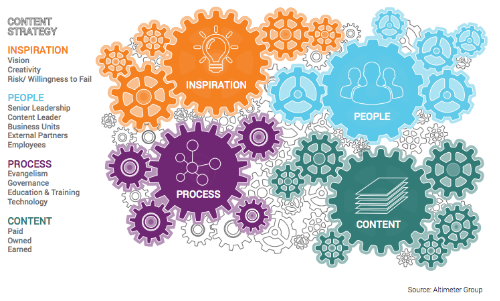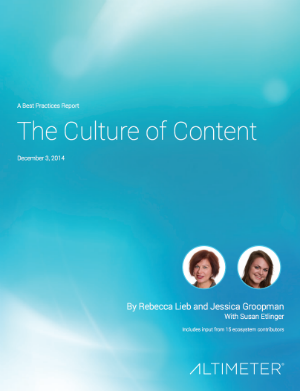
Content at scale is something many business leaders anticipate, but few know how to implement with any measure of quality.
As companies come to appreciate the role of content as an essential business function, there come a number of opportunities to lead the way towards developing a culture of content. Companies that evangelize and institutionalize the importance of content find success beyond marketing into multiple business areas from customer service to talent acquisition.
This is essentially the research supported point of view that Rebecca Lieb and Jessica Groopman of Altimeter Group have provided in a new best practices report: The Culture of Content.
Content beyond marketing is what will drive success across business functions in the coming year and beyond – from marketing and sales, to employee advocacy, customer service, audience engagement, to thought leadership and hiring, content touches all aspects of a business and all areas of a business can contribute to the content function.
Channel, platform and device proliferation, as well as always-on social media initiatives such as social selling, thought leadership, real-time marketing, and customer service, and recruitment, demand that brands continually create, refine, repurpose and reformat their original content. It’s no wonder that the need for a Culture of Content has emerged. Demand for content is more than ever and content can be discovered, consumed and acted on just about anywhere. On top of that, media and channels continue to proliferate along with the convergence of paid and owned media.
But what does a culture of content look like in an organization? What kind of mechanics make a well oiled content machine?

That’s what Altimeter’s new research illustrates as the “anatomy” of a culture of content, including 4 key components: inspiration, people, process, and content. Below are excerpts from the report in each area:
Inspiration – As an example, charity: water, a nonprofit that works to provide clean drinking water to developing countries, uses content to drive its vision and its vision to drive content. Inspired by charity: water’s content and mission, Seattle-based EastLake Community Church created a content and event series that raised more than $709,000, enough to provide 54,541 Cambodians with access to clean water.
People – No tool or technology is as essential to CoC as people are. Nestlé uses outside relationships to foster more creativity and experimentation. Mondel?z also seeks partners to create enough content to steadily feed to media and social channels
Process – Establishing clear processes, roles, and resources helps a culture of content thrive and evolve over time. Kraft’s content center of excellence is developing a formal training curriculum to educate marketers on how to create strategy, what great content looks like, what tools are in place, and how they streamline processes, as well as what other resources are available and what measurement methodologies to use.
Content – Content is the atomic particle of all marketing across paid, owned, and earned channels. A Culture of Content starts with an obsession of customer, says Michael Brenner, head of strategy at NewsCred. Whether listening to customer feedback directly or monitoring customer interactions across various touch points, companies with a well-defined CoC are equipped to optimize rapidly based on customer insights.
“A culture of content exists when the importance of content is evangelized enterprise wide, content is shared and made accessible, creation and creativity are encouraged, and content flows up and downstream, as well as across various divisions.”
Creating enough quality content is a problem many brands are facing and research from CMI/MarketingProfs as well as other industry resources have proven year after year that this is a concern. While creating a culture of content puts companies on the right track towards a scalable content strategy, many companies are seeking outside help by engaging resources for content planning, creation, promotion, measurement and performance optimization. This is the essence of what we do at TopRank Online Marketing.
For anyone digging in to their content strategy and content marketing plans for 2015, this report is a great resource. In addition to the insights from Rebecca Lieb, Jessica Groopman and Susan Etlinger, Altimeter tapped an ecosystem of digital marketing experts for their insight for this report that includes:
- Carlos Abler, Leader of Online Content Strategy, 3M
- Gina Ballenger, Content Strategist & Brand Advocate, Twitter
- Connie Bensen, Global Social Strategy, Dell
- Pete Blackshaw, Global Head of Digital & Social Media, Nestlé
- Bonin Bough, VP of Global Media and Consumer Engagement,
Mondelez - Ben Boyd, President, Practices, Sectors, & Offerings, Edelman
- Michael Brenner, Head of Strategy, Newscred
- Emily Cloud, Digital Manager, Purina / Nestlé North America
- Gurdeep Dhillon, Global VP Marketing, SAP
- Julie Fleischer, Director, Data + Content + Media, Kraft Foods
- Nico Henderijckx, European Forum & Community Manager, Sony
Europe - Kyle Lacy, Director, Global Content & Research, Salesforce.com
- Stacy Minero, Head of Planning, Twitter
- Rick Short, Director of Marketing & Communications, Indium
- Paull Young, Director of Digital, charity:water
Here’s the full report: The Culture of Content.

Top image: Shutterstock


